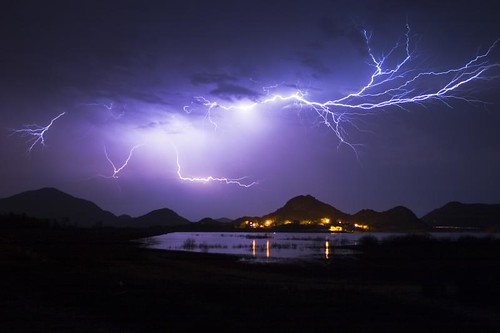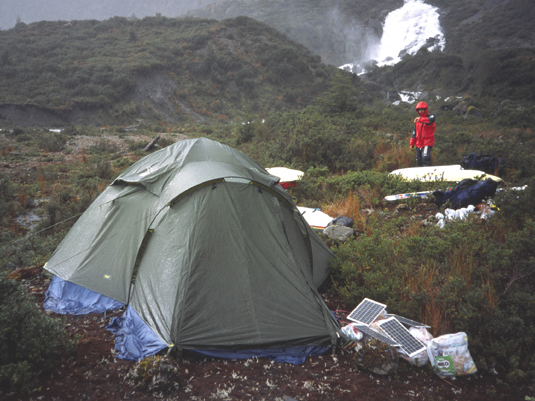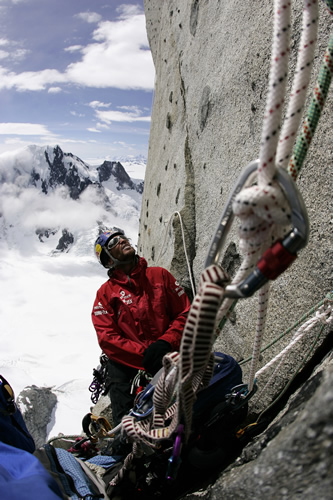
Few weather events are so impressive and fearsome as the storms on the mountain. The speed with which they form and its unusual violence can put up stiff resistance to anyone who is caught by them without the possibility of shelter. In gullies occurs within seconds floods that drag everything in its path, including the helpless climbers who could not get out of bed on time. The consequences in these cases tend to be almost always fatal, either by drowning or traumatic injuries. Climbers must fight the wind, hail, the sudden drop in temperatures and waterfalls and rocks falling from the top. In the best case the wet rock is slippery and increases the difficulty of the ascent or retreat.
The air sports fans, such as paragliding and hang gliding could be undone by being unbalanced their devices by strong turbulence, or be drawn into the heights by the rising air currents that accompany all storms with the risk death by hypoxia or cold. And finally, there is always the possibility of being struck by lightning.
Knowing how they occur, the signals to which we must be vigilant, and as a refuge where we can protect ourselves from this amazing and potentially dangerous release of energy.
Alarm Signals:
– Approximation of dark clouds, very high and flat on top (anvil cloud).
– Feeling tingling of the skin.
– Hair bristles.
– Metal objects beeps.
– Luminescence appears in sharp objects.
– There is risk in any thunderstorm in which fewer than ten seconds between lightning and thunder.
Hazardous Locations:
Those who can act as a lightning rod:
– Tops of the mountains.
– Ridges, edges or gendarmes.
– Isolated blocks of stone.
– Isolated trees.
– Cabins isolated, especially by the fireplace, doors and windows.
– Masts tent type «Canadian».
– In general, any prominent area.
Those who can conduct ground currents:
– Cracks or fissures wet.
– Small cavities.
– Torrents of water.
– Handrails and metal pins.
– Can also be dangerous to stay with herds and use electrical or powerful flashes.

Relatively safe places:
– At the base of rocky ridges of at least 15 feet high. The safety zone starts at about 2 meters from the wall and reaches a similar length to the height of the protrusion. However, this area provides no protection against ground currents.
– Caves or cavities deep: from the climber’s head to the roof must have a distance of at least one meter. Avoid the entrance to the cave and the background. Staying away from the walls.
Safe places:
– Inside the car, with doors and windows closed, disconnected power outlets and antenna collection.
– Within the aircraft.
– Within the cable cars.
Standards of Self: On open ground
– Avoid the danger zones.
– Move the equipment away cash, but not rid of him.
– Squatting isolated from soil with a backpack, rope, or a sleeping bag, can also serve as a flat stone.
– Do not lean against the wall. Staying away from it.
– Do not use appliances or flashes.
– Prevent the ax protruding above the pack.
Not Use :
The vertical metal poles stores (Canadian type) are dangerous.
– Remain seated squat, isolated from soil with backpacks, ropes, mats, etc.. and climbing helmet as if it were available.

During the climb:
– Do rappelling, the wet string can conduct electricity and forcing the hands drop.
– Move the equipment away cash, but never throw (may be needed later).
– Do not lift the ax or hammer over the head.
– Ensure the wall separated from her at least one meter perpendicular to the possible path of electrical current. Squatting on the climbing rope or backpack.
Effects of lightning strikes:
– If the impact is direct, sudden death.
– If there is a potential indirect impact of survival, but serious injury can occur.
– Respiratory arrest.
– Injuries.
– Loss of consciousness, disorientation, amnesia.
First Aid:
– Assessment of vital signs immediately. Cardio-pulmonary resuscitation immediately if so required.
– Treatment of burns and wounds.
– Evacuation to a hospital.
Finally, say that the possibility of a lightning discharge is very small, however, this probability increases almost if not meet minimum safety requirements. As data in some countries more people die from electrical shock by the flooding that drowned. So the weather will remain the best card for the climber or mountaineer. You better stay at home or at the shelter and lose a day’s activity to risk for nothing, storms and mountains will remain motionless.
Good travel!
Leave a Reply
You must be logged in to post a comment.
Recent Comments